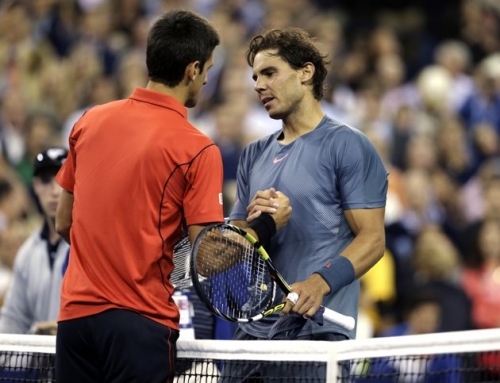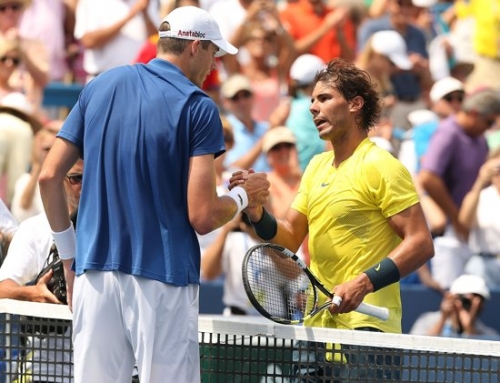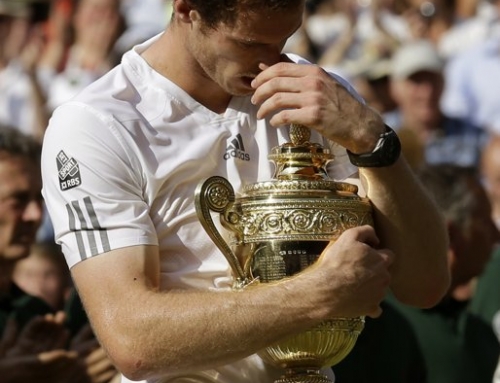Until the 1970s, the amount of tennis coverage in the US was quite limited. For example, the first “Breakfast at Wimbledon” was in 1979. This was the first live telecast of Wimbledon men’s final. It was thought that few would wake up to watch a sporting event, so it was tape delayed. Indeed, for many years, the French Open women’s final was televised tape delayed. Tape delay was used so frequently in the 1970s that many forget that the “Do you believe in miracles?” hockey game between US and Russia was tape delayed and not shown live.
The late 1970s changed everything as cable TV became increasing common and ESPN, the premier sports channel in the US. USA Network was the other competing network with its mix of reruns of old shows, bad movies, and sporting events. They used to cover the US Open during hours CBS did not cover it. Despite cable having been around for some 35 years, Tennis Channel didn’t arrive on the scene until about 5 years ago.
Players that played in the 1960s and earlier would only have some fame if they were really really good. Thus names like Rod Laver, Ken Rosewall, Pancho Gonzalez, Jack Kramer, and so forth were famous because they were good. There was no pro tour in the 1960s, at least, not until 1968, so much like the American Idol top 10 tour (you have to be in the top 10 to go to the summer tour), only the best went pro and earned money as a pro.
Many other players faded to obscurity.
But in the 1980s, another invention came out that proved critical to preserving the memories of tennis from the 1980s: the VCR. As amazing as the VCR is, it was almost made illegal. Even in the early days of cable television, content providers were scared people would record and distribute content. Fred Rogers, better known as Mr. Rogers of Mr. Rogers Neighborhood, testified to Congress that parents may want to watch his show at later hours, and so VCRs were permitted.
This allowed fans to record matches, albeit on poor quality medium, not the HD stuff of today. And when YouTube came out in 2005, some of these fans began to comb through their old content and put it up.
This meant a player as obscure as Miloslav Mecir could still be watched today.
Many of the best East European players came from what was then called Czechoslovakia. On the women’s side, there was Martina Navratilova, who eventually defected and became an American. On the men’s side was Ivan Lendl, who perhaps should have earned many more Slams than he did.
A geography neophyte might look at “Czechoslovakia” and wonder if it came from two parts: Czech and Slovakia. And indeed, it did. When the Soviet Union fell apart, the country of Czechoslovakia split into the Czech Republic and Slovakia. Many of the players coming from Czechoslovakia were Czech, including Lendl and Navratilova.
Mecir, on the other hand, was a Slovak. He was given a nickname “The Big Cat” apparently from an Italian tennis reporter, and it was repeated often by the floral Mary Carillo. Mecir moved effortlessly across the court. He was also known as the Swede Killer. In the 1980s, the Swedes were a formidable group. It included Mats Wilander, Joachim Nystrom, Anders Jarryd, Stefan Edberg, Henrik Sundstrom, and eventually Kent Carlsson and Jonas Bjorkman.
Sweden is a tiny country with a population just under 10 million. There are plenty of cities in the world that have 10 million people. Consider India which has a billion people over 100 times the population of Sweden and yet Sweden does an incredible job at per capita athletes using a system more often seen in communist countries (creating cheap sports clubs and having sports experts identify and cultivate talent). Much like the Spaniards of today and the Aussies of the 1960s and earlier, the Swedes of the 1980s trained together and made each other better.
Mecir had a game that baffled nearly all the Swedes. It was said the “Big Cat” would lull his opponents to sleep, and boom, hit a shot up the line. Mecir didn’t hit with much topspin. His strokes didn’t look particularly pretty, but he could hit both a sharp angle backhand and thread this shot up the line. He’d often be engaged in a casual crosscourt backhand rally and boom, hit an up the line shot, with his opponent wondering where that shot came from.
Mecir was able to hit shots up the line on his forehand too. This ability to hit shots up the line made Mecir dangerous. He was also an exceptional returner.
And one could argue that Mecir played a style that was years ahead of its time. In particular, Mecir didn’t serve and volley a great deal, but he came to net rather frequently. By the way, if you need a new net, newer technology is providing great tennis nets for sale. Most people who remember Mecir probably don’t recall how good a volleyer he was because we were so used to seeing serve and volleyers, more like Edberg, than a baseliner looking to approach.
Here’s a sample of Mecir’s game: http://www.youtube.com/watch?v=4_34nkKIUXc
This was a match between Mecir and Lendl in Key Biscayne, what would now be called the Sony Ericsson Open. Mecir’s forehand, notably, looks very casual, almost classic in it’s approach. And he’ll practically push, push, push the ball, then up the pace on a ball. When Lendl tries to hit a bigger shot, Mecir is quick enough to run it down.
Wait until about 4:30 into the clip when Mecir hits a crosscourt backhand that clips the net, and pops up short. Lendl swoops in and hits a sharply angled crosscourt backhand, almost a passing shot with Mecir at the baseline. Mecir has to scramble to his left, nearly 15 feet off the side to hit a recovery shot. Lendl it a bit handcuffed and returns a crosscourt shot and Mecir recovers with a crosscourt of his own. Lendl hits a sharper crosscourt and eventually Mecir hits a good up the line forehand and Lendl nets the slice into the net with Mecir approaching the net.
Another classic match was Mecir playing in the 1987 quarterfinal where he would lose to Mats Wilander.
Mecir would show a modern ability to hit passing shots in difficult situations. If you watch this, you’ll see how often Mecir comes to net and how he volleyed quite well despite not being a traditional serve and volleyer.
Mecir would reach two Slam finals, once in the 1986 US Open and once in the 1989 Australian Open, losing both to Ivan Lendl in straight sets. Unusually enough, Mecir played the 1986 US Open with a wooden racquet, the last time a player would reach the final of a Slam playing with wood. He would win a gold medal in the Olympics in 1988 to give him something to look back on and also won bronze in doubles.
He would win his last title in Indian Wells in 1989, winning a five setter over Yannick Noah.
Mecir turned pro as an 18 year old in 1982, but 8 short years later, he’d retire in 1990, due to back injuries, at the age of 26.




![[US Open Men’s Final] Can Djokovic beat Nadal in the finals?](https://www.essentialtennis.com/wp-content/uploads/2013/09/20130909djokovic-500x383.jpg)


![[French Open] The tactics of the Djokovic-Nadal semifinals](https://www.essentialtennis.com/wp-content/uploads/2013/06/20130607nole-500x383.jpg)